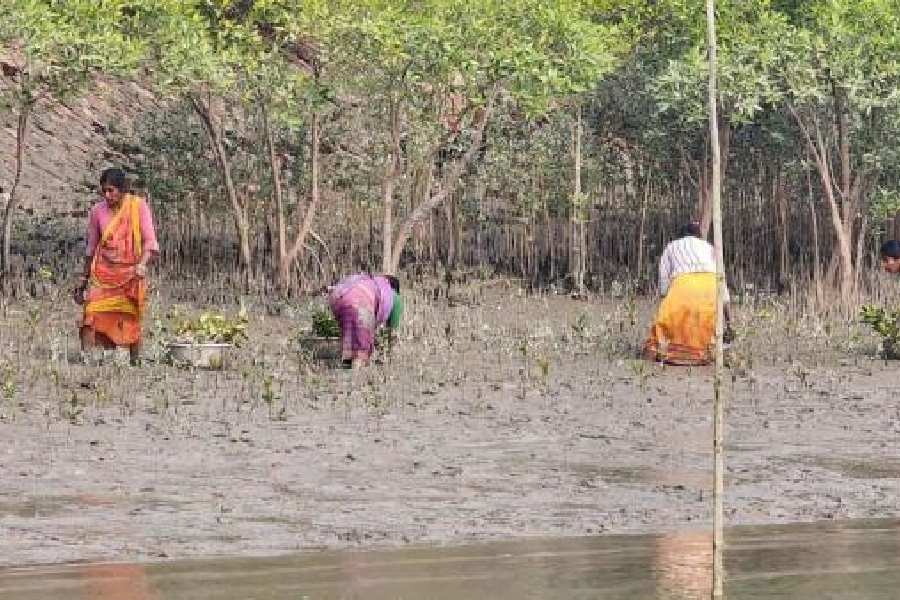A cash crunch has forced the state forest department to involve NGOs in planting mangrove trees in the Sunderbans.
Till before the previous financial year, trees were planted by residents who were paid by the forest department under the 100-day rural job scheme, mandated by the Mahatma Gandhi National Rural Employment Guarantee Act.
“We had planted over 17 crore mangrove saplings in two financial years, 2020-21 and 2021-22. But in the previous fiscal (2022-23), there was zero plantation. In my division alone, around Rs 22 crore payment is pending. Out of the total amount, unpaid wages run up to Rs 14 crore. The funds crunch has led us to assign the plantation drive to NGOs,” said Milan Mandal, divisional forest officer of the South 24-Parganas forest division.
The Centre has stopped releasing funds under the rural job scheme, alleging misappropriation of grants in Bengal. Trinamul, Bengal’s ruling party, has denied the charge and accused the BJP government at the Centre of political discrimination.
On July 26, celebrated as The International Day for the Conservation of the Mangrove Ecosystem, the forest department gave work orders to two NGOs.
The mandate of the order — plant new saplings and take care of the existing plantations on 2,500 hectares of “non-forest” land in the Sunderbans Biosphere Reserve. They have to employ local people in the work.
The South 24-Parganas district administration has made it clear that the local people who have wages pending in the previous phases of the plantation drive must get priority in the new project.
"Non-forest land" means the area on the riverbanks near the villages on the fringes of the forest area, also under the jurisdiction of the forest department.
“Forest access is limited to forest staff or people working under the direct supervision of forest staff. But for fringe areas, we have asked two NGOs to plant and maintain mangroves,” said Mandal.
Cyclones Amphan and Yaas, which struck 2020 and 2021, had ravaged the mangrove cover across the delta. The scale of the loss prompted a plantation overdrive from the Bengal administration, aimed at compensating for the loss in the green cover.
Mangrove trees not only protect the Sunderbans from ferocious storms but also act as a buffer for Kolkata, around 100km away.
It takes around four to five years for a mangrove sapling to become a tree.
“It is true that a lot of trees have been planted. But the health of the trees also needs a thorough evaluation. We have to plant new saplings and maintain the plants. We will conduct a comprehensive health audit of the mangroves,” said Sourav Mukherjee, founder director of Kolkata Society For Cultural Heritage (KSCH), one of two NGOs that got the work order.
KSCH has been allotted a little over 1,000 hectares across three ranges — Raidighi, Ramganga and Bhagabatpur.
“If successful, the project can generate more than two lakh man-days of work in a year. We have set ourselves a target of planting 2 crore mangroves in the area in the next five years,” said Mukherjee.
Debabrata Mondal of the NGO Go Dharmic Welfare Foundation, which has been allotted 1,500 hectares, said: “Our main focus will be on maintaining the existing plantation. Beside that, we have a target of planting around two million new plants in the first phase.”
Mukherjee of KSCH said his organisation was in talks with several private companies who have shown interest in investing in the project as part of their corporate social responsibility.
Multiple companies are part of the carbon market and looking for carbon credits, he said.
Carbon markets are trading systems in which carbon credits are sold and bought.
“Companies or individuals can use carbon markets to compensate for their greenhouse gas emissions by purchasing carbon credits from entities that remove or reduce greenhouse gas emissions,” says the website of the United Nations Development Programme.
Mangrove ecosystems are well known for carbon absorption.
